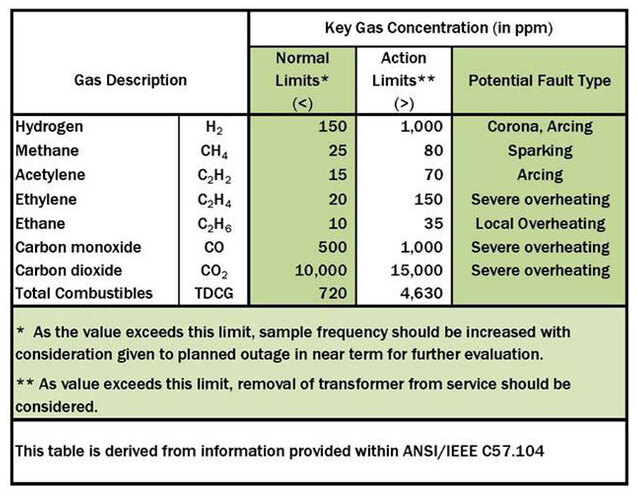Dissolved gas analysis (DGA) is the study of gas content in transformer oil. When a transformer is subjected to abnormal thermal conditions and electrical stresses, certain gases are produced due to the decomposition of the insulating fluid. By observing the composition of different gasses present in the oil, lab technicians can accurately predict the internal condition of the transformer.
Hydrogen (H2)
- Most electrical or thermal fault conditions are evidenced by the presence of Hydrogen gas in oil.
- Found at temperatures starting around 200°C.
- Produced across the entire spectrum of fault temperatures.
- Increases in quantity as temperature increases.
- The universal choice for single gas fault monitoring.
- Indicator of partial discharge activity, overheating of oil, electrolysis of free water.
- Most abundant element in the universe, sun is mostly hydrogen.
- Hydrogen can be used to power vehicles, generate electricity, power industry and heat but requires more energy to produce.
Methane (CH4)
- Indicates partial discharge activity, overheating of insulating fluid.
- Produced across the entire spectrum of fault temperatures.
- Found at temperatures starting around 200°C.
- Decreases in quantity as fault temperatures rise above 250°C.
Ethane (C2H6)
- Medium temperature thermal heating gas, generally between 300°C – 700°C.
- Indicates overheating of oil, found at temperatures starting around 250°C.
- Decreases in quantity as temperatures approach 300°C.
- Colorless and odorless.
Carbon Monoxide (CO) / Carbon Dioxide (CO2)
- Primarily formed through the breakdown of the cellulose insulation.
- Indicates the overheating of paper insulation, CO2/CO ratio provides additional information.
- Rate of formation and relative composition is influenced by the amount of paper in the fault region.
- Can also be generated from the insulating oil and other components, particularly when the oxygen content is high.
- Generally gives better information for localized overheating.
Acetylene (C2H2)
- Indicates arcing in oil, very high temperatures.
- Found in small quantities around 500°C.
- Rapid increase of large concentrations starting at 700°C.
- Important at any detectable concentration.
- Higher proportions indicate a critical arcing fault is likely present.
- 1 ppm of acetylene would be considered a possible serious indicator if found in a new transformer.
Ethylene (C2H4)
- Ethylene (C2H4) is an indication of a very high-temperature hot spot inside an electrical transformer.
- Overheating of oil, associated with higher temperature overheating.
- Found at temperatures starting around 350°C.
- Decreases in quantity with arcing conditions starting at temperatures above 700°C.
- Not useful for detecting hot spots of increasing temperature.
Oxygen (O2)
- Typically present from residual air, air ingress, or can be generated from electrolysis of free water.
- Will always be present in varying amounts.
- May indicate leaky gaskets on transformer tanks and tap changers.
- Capable of carrying moisture into transformer fluid.
- High concentrations can increase the rate of formation in some measured gases.
Nitrogen (N2)
- Typically present from inert nitrogen pressure system, residual air, air ingress.
- High nitrogen levels can indicate incomplete transformer degassing or air ingress.
- May indicate extreme overpressure in a gas blanketing system.
Further Reading
- IEEE C57.104 Guide for the Interpretation of Gases Generated in Oil-Immersed Transformers
- Transformer Furan Analysis
- The Power of Dissolved Gas in Oil Analysis
- Hydrogen Gas in Transformers
- The Importance of Measuring Oxygen in DGA
- Transformer Dissolved Gas Analysis Questions and Fault Identification Methods

